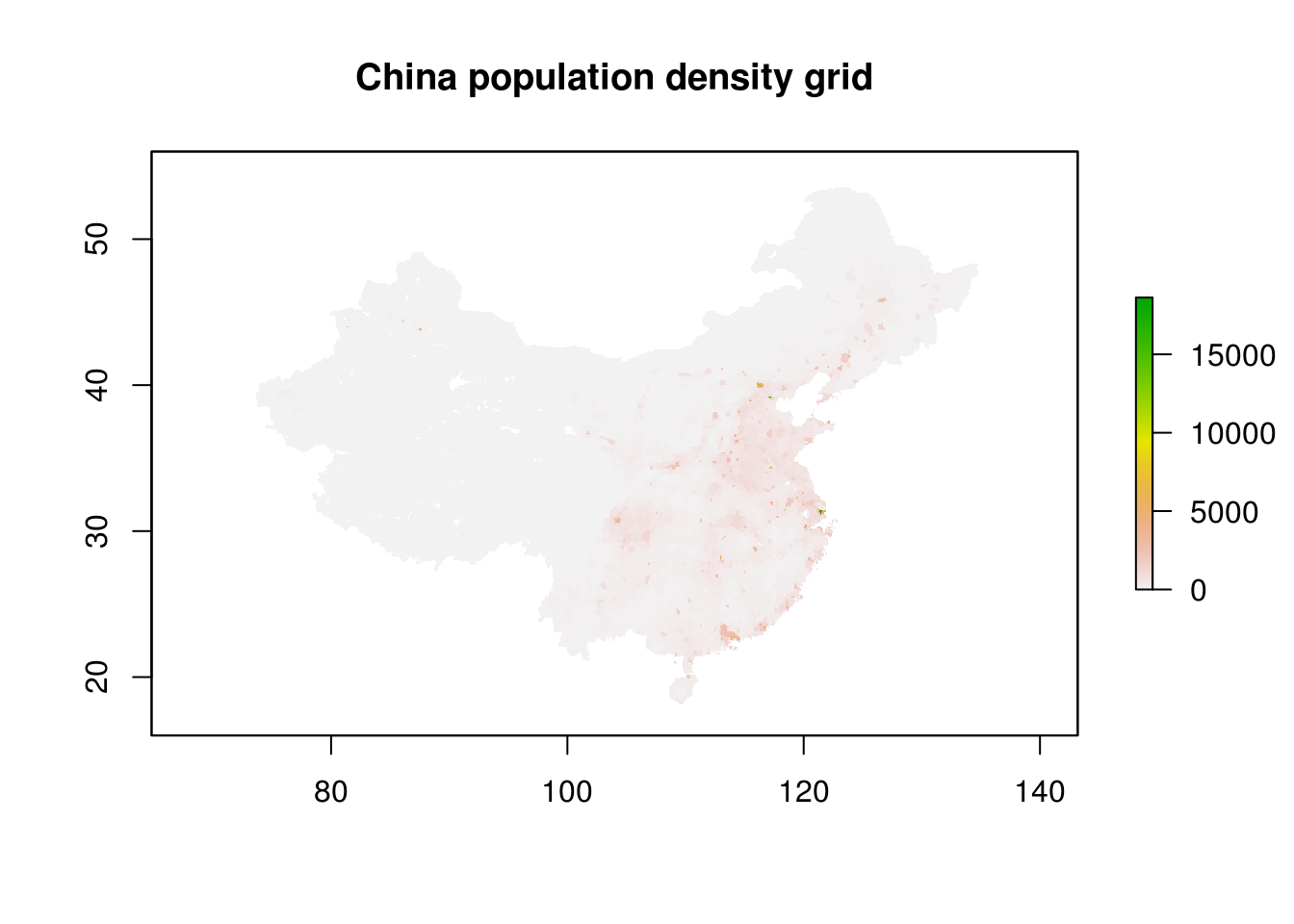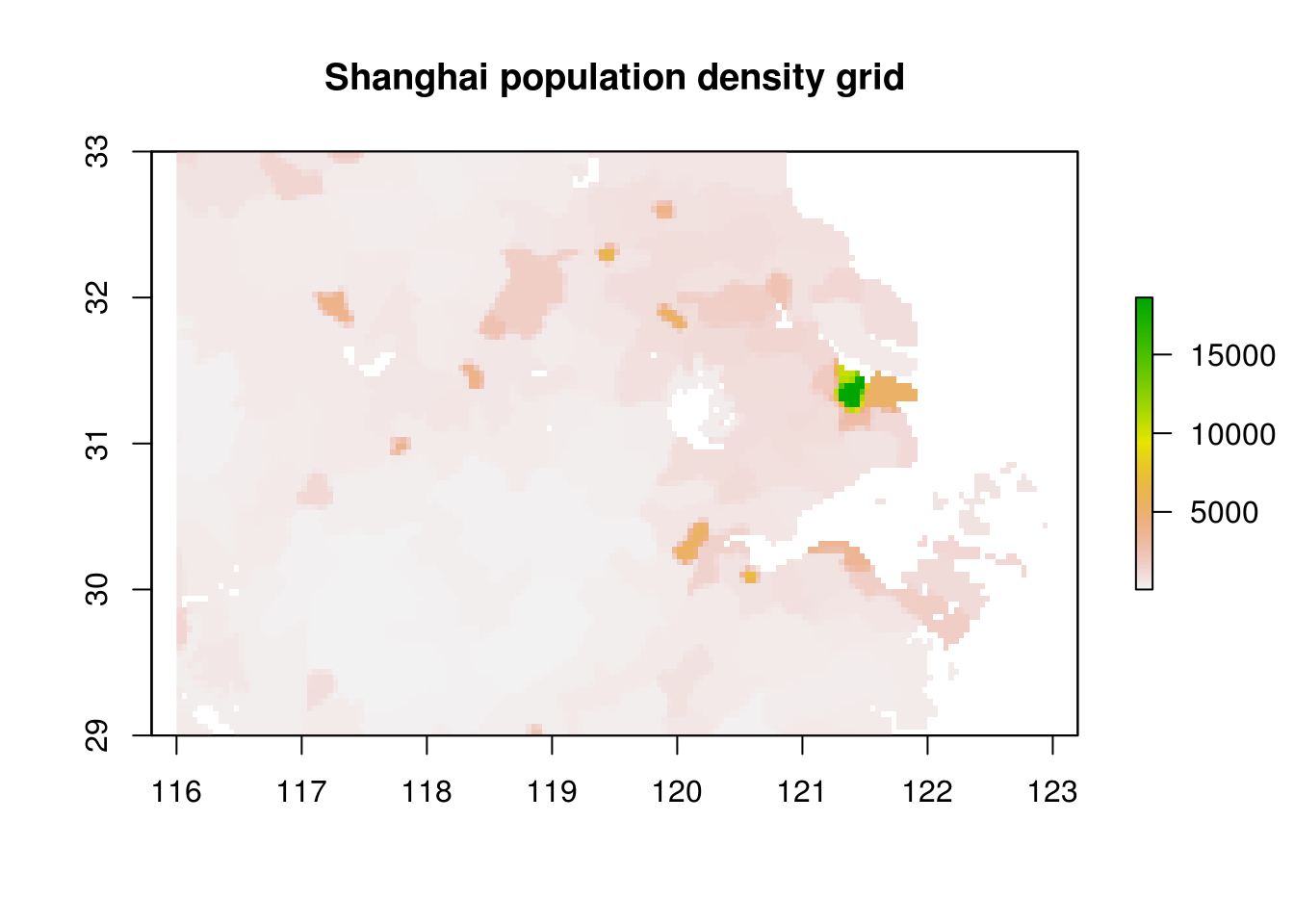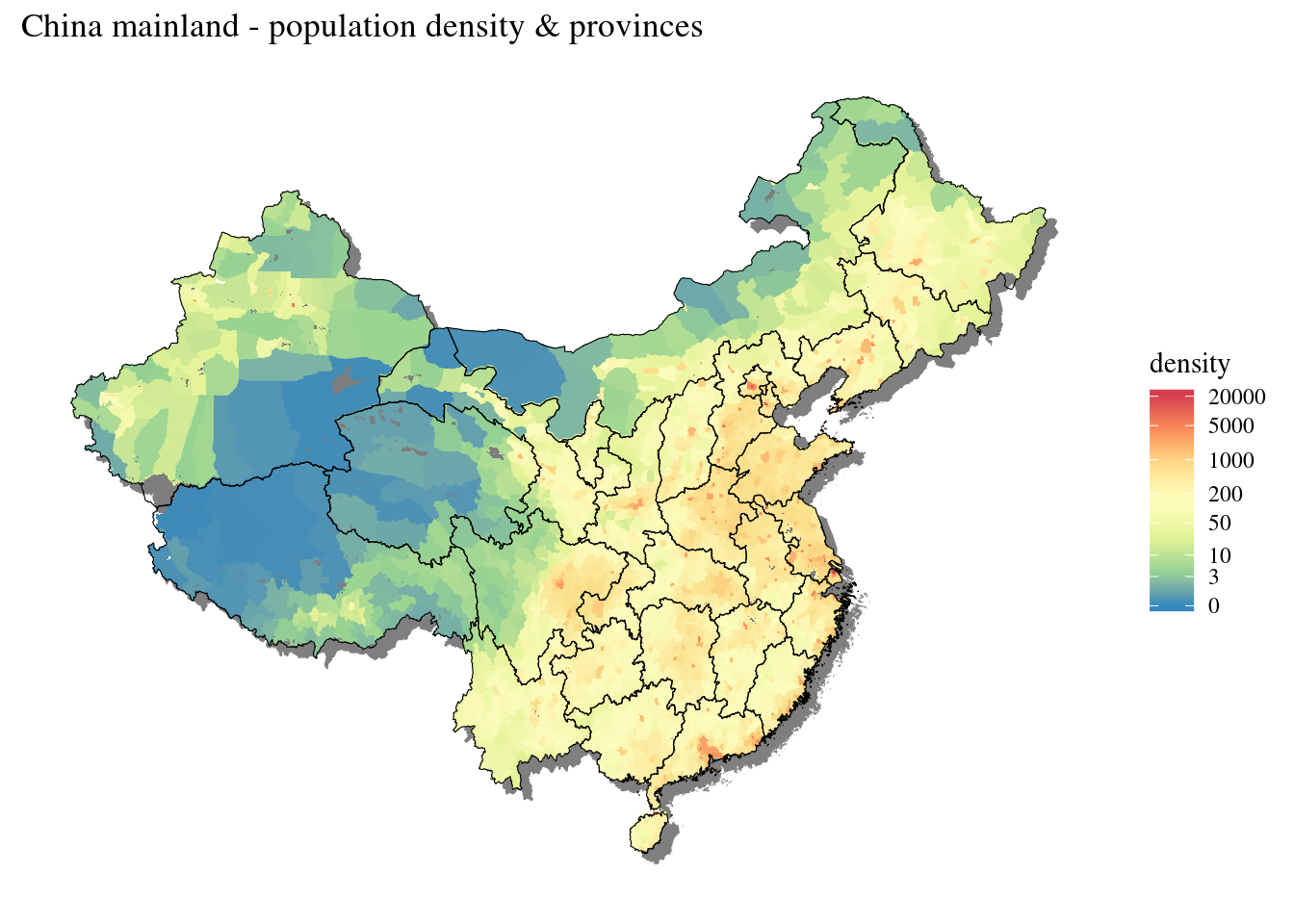By Datapleth.io | July 14, 2016
In an earlier post we mapped the urbanization rate of China at province level. In this post we will go futher by visualizing where Chinese people are living using a gridded population map.
We will use the NASA dataset (Population Density Grid, v3 (1990, 1995, 2000)) which consists of estimates of human population by 2.5 arc-minute grid cells.
A proportional allocation gridding algorithm, utilizing more than 300,000 national and sub-national administrative units, is used to assign population values to grid cells. The population density grids are derived by dividing the population count grids by the land area grid and represent persons per square kilometer.
Required libraries
We need several R packages for this study.
library(maptools)
library(rgdal)
library(raster)
library(ggplot2)
library(ggthemes)Get and clean population and grid data
The data is available for free to download on SEDAC website https://sedac.ciesin.columbia.edu/data/set/gpw-v3-population-density
Please note that the Trustees of Columbia University in the City of New York and the Centro Internacional de Agricultura Tropical (CIAT) hold the copyright of this dataset. Users are prohibited from any commercial, non-free resale, or redistribution without explicit written permission from CIESIN or CIAT. Users should acknowledge CIESIN and CIAT as the source used in the creation of any reports, publications, new data sets, derived products, or services resulting from the use of this data set.
There are 3 formats available: .bil, .ascii or .grid
(https://en.wikipedia.org/wiki/Esri_grid)
We will use directly the ASCII version which can be read with readAsciiGrid()
from the maptool package.
We select data for China only and download 1 datasets : Population density grid; We use a cached version stored on datapleth.io cloud and load the file raster.
# chnds00g population densities in 2000, unadjusted, persons per square km
densGriCountFile <- "https://data.datapleth.io/ext/gridded-Population-of-China/chndens-ascii/chnds00g.asc"
download.file(
url = densGriCountFile,
destfile = "./data/chnds00g.asc",
method = "wget", quiet = TRUE,
mode = "w", cacheOK = TRUE
)
dens <- raster::raster("./data/chnds00g.asc")
raster::fromDisk(dens)## [1] TRUEVisualise gridded data
plot(dens, main="China population density grid")
# Around Shanghai
plot(
crop(
dens,
c(116, 123, 29, 33)
),
main="Shanghai population density grid"
)
Toward a map of China density
We first load China map with regions (see earlier post)
ChinaPolygonsLevel1 <- rgdal::readOGR("./data/CHN_adm1.shp")## OGR data source with driver: ESRI Shapefile
## Source: "/home/travis/build/longwei66/datapleth/content/blog/data/CHN_adm1.shp", layer: "CHN_adm1"
## with 31 features
## It has 9 fields
## Integer64 fields read as strings: ID_0 ID_1## Fix English names, simplify
ChinaPolygonsLevel1@data$NAME_1 <- as.character(ChinaPolygonsLevel1@data$NAME_1)
ChinaPolygonsLevel1@data[grep("Xinjiang Uygur", ChinaPolygonsLevel1@data$NAME_1),]$NAME_1 <- "Xinjiang"
ChinaPolygonsLevel1@data[grep("Nei Mongol", ChinaPolygonsLevel1@data$NAME_1),]$NAME_1 <- "Nei Menggu"
ChinaPolygonsLevel1@data[grep("Ningxia Hui", ChinaPolygonsLevel1@data$NAME_1),]$NAME_1 <- "Ningxia"
ChinaPolygonsLevel1@data$NAME_1 <- as.factor(ChinaPolygonsLevel1@data$NAME_1)
# Use level1 as index & Province name as id
ChinaLevel1Data <- ChinaPolygonsLevel1@data
ChinaLevel1Data$id <- ChinaLevel1Data$NAME_1
# Fortify the data (polygon map as dataframe) using english names
ChinaLevel1dF <- ggplot2::fortify(ChinaPolygonsLevel1, region = "NAME_1")
## Merge polygons and associated data in one data frame by id (name of the province in chinese)
ChinaLevel1 <- merge(ChinaLevel1dF, ChinaLevel1Data, by = "id")
rm(ChinaPolygonsLevel1, ChinaLevel1dF, ChinaLevel1Data)Then we convert the density raster data to data.frame in order to use ggplot in the next steps.
## convert the raster to points (to plot with ggplot)
raster_points_dens <- raster::rasterToPoints(dens)
raster_points_dens <- data.frame(raster_points_dens)
colnames(raster_points_dens) <-c('x','y','density')We make a first plot.
md <- ggplot(data=raster_points_dens, aes(y=y, x=x))
md <- md + geom_raster(aes(fill=density))
md + scale_fill_gradient(low="white", high="blue")
The problem of this visualisation is the large extend of distribution of densities. China is definitely a wide country which is dense and empty at the same time ! So we switch to a log scale to get a better vizualisation.
qplot(
x = raster_points_dens$density,
fill=..count..,
geom="histogram",
bins = 200
)
qplot(
x = log(raster_points_dens$density+1),
fill=..count..,
geom="histogram",
bins = 200
) 
Map of China density grid
As described above, we use a log(x+1) scale for the color scale
(using trans="log1p") in the geom_raster.
g <- ggplot() + theme_tufte() +
## Projected shadows
geom_polygon(
data = ChinaLevel1,
aes(x = long + 0.7, y = lat - 0.5, group = group),
color = "grey50", size = 0.1, fill = "grey50"
) +
## Add Raster
geom_raster(
data=raster_points_dens,
aes(y=y, x=x, fill=density)
) +
scale_fill_distiller(
palette = "Spectral",
trans="log1p",
breaks = c(0, 3, 10, 50, 200, 1000, 5000, 20000)
) +
## Province boundaries
geom_polygon(
data = ChinaLevel1,
aes( x = long, y = lat, group = group, fill = NULL),
alpha = 0.01, color = "black", size = 0.2
) +
## Styling
labs(title = "China mainland - population density & provinces") +
theme( axis.text=element_blank(), axis.ticks=element_blank(),
axis.title=element_blank())
print(g)
References
Source
Center for International Earth Science Information Network - CIESIN - Columbia University, United Nations Food and Agriculture Programme - FAO, and Centro Internacional de Agricultura Tropical - CIAT. 2005. Gridded Population of the World, Version 3 (GPWv3): Population Count Grid. Palisades, NY: NASA Socioeconomic Data and Applications Center (SEDAC). https://doi.org/10.7927/H4639MPP. Accessed 2019-12-12.
Other example of use of raster package
https://pakillo.github.io/R-GIS-tutorial/#raster http://zevross.com/blog/2015/03/30/map-and-analyze-raster-data-in-r/ https://jeffreybreen.wordpress.com/tag/raster/

